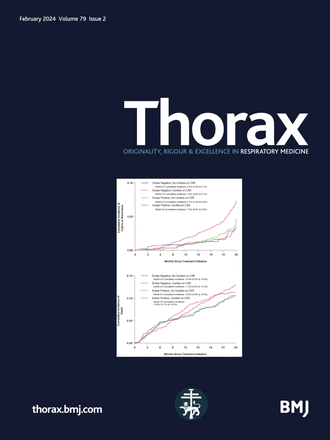Preserved ratio impaired spirometry (PRISm): prognostic, preventable and treatable?
IF 9
1区 医学
Q1 RESPIRATORY SYSTEM
引用次数: 0
Abstract
Spirometry is a crucial lung function test, which is primarily aimed at identifying airway obstruction in subjects with chronic symptoms of shortness of breath or cough. An obstructive pattern is defined as an impaired ratio of forced expiratory volume in 1 s (FEV1) to forced vital capacity (FVC) (ie, FEV1/FVC less than the lower limit of normal (LLN)) (figure 1). It may be caused by asthma and/or chronic obstructive pulmonary disease (COPD) and warrants further testing including bronchodilator responsiveness. Spirometry is essential for diagnosing asthma and COPD, but also for monitoring the course of these highly prevalent chronic airway diseases, including the response to treatment, the level of short-term asthma control and the occurrence of long-term clinical remission. However, there is a second spirometric pattern which is important to discern in clinical practice: preserved ratio impaired spirometry (PRISm), defined as a preserved FEV1/FVC ratio but impaired FEV1 (ie, FEV1 less than 80% predicted). Only recently, PRISm has attracted more attention. Figure 1 The main spirometric patterns encompass an obstructive pattern, a normal spirometry and preserved ratio impaired spirometry (PRISm). BMI, body mass index; COPD, chronic obstructive pulmonary disease; FEV1, forced expiratory volume in 1 s; FVC, forced vital capacity; HDL, high-density lipoprotein; LE8: Life’s Essential 8; LLN, lower limit of normal. PRISm, affecting approximately 6%–18% of the adult general population and elicited by multiple conditions, is associated with …保留比例肺功能受损(PRISm):预后、可预防和可治疗?
肺活量测定是一项至关重要的肺功能测试,主要目的是在有慢性呼吸短促或咳嗽症状的受试者中识别气道阻塞。阻塞性模式被定义为用力呼气量(FEV1)与用力肺活量(FVC)之比受损(即FEV1/FVC低于正常下限(LLN))(图1)。它可能由哮喘和/或慢性阻塞性肺疾病(COPD)引起,需要进一步检测,包括支气管扩张剂反应性。肺活量测定对于诊断哮喘和慢性阻塞性肺病至关重要,而且对于监测这些高度流行的慢性气道疾病的病程也至关重要,包括对治疗的反应、短期哮喘控制水平和长期临床缓解的发生。然而,在临床实践中,有第二种重要的肺活量测定模式:保留比率受损肺活量测定(PRISm),定义为保留FEV1/FVC比率,但FEV1受损(即FEV1低于预测的80%)。直到最近,棱镜计划才吸引了更多的关注。图1主要的肺活量模式包括阻塞性肺活量模式、正常肺活量模式和保存率受损肺活量模式(PRISm)。BMI,身体质量指数;慢性阻塞性肺疾病;1 s内FEV1、用力呼气量;FVC,强迫肺活量;HDL,高密度脂蛋白;LE8:生命的真谛;LLN,正常下限。PRISm影响了大约6%-18%的成年人,并由多种条件引起,与…
本文章由计算机程序翻译,如有差异,请以英文原文为准。
求助全文
约1分钟内获得全文
求助全文
来源期刊

Thorax
医学-呼吸系统
CiteScore
16.10
自引率
2.00%
发文量
197
审稿时长
1 months
期刊介绍:
Thorax stands as one of the premier respiratory medicine journals globally, featuring clinical and experimental research articles spanning respiratory medicine, pediatrics, immunology, pharmacology, pathology, and surgery. The journal's mission is to publish noteworthy advancements in scientific understanding that are poised to influence clinical practice significantly. This encompasses articles delving into basic and translational mechanisms applicable to clinical material, covering areas such as cell and molecular biology, genetics, epidemiology, and immunology.
 求助内容:
求助内容: 应助结果提醒方式:
应助结果提醒方式:


